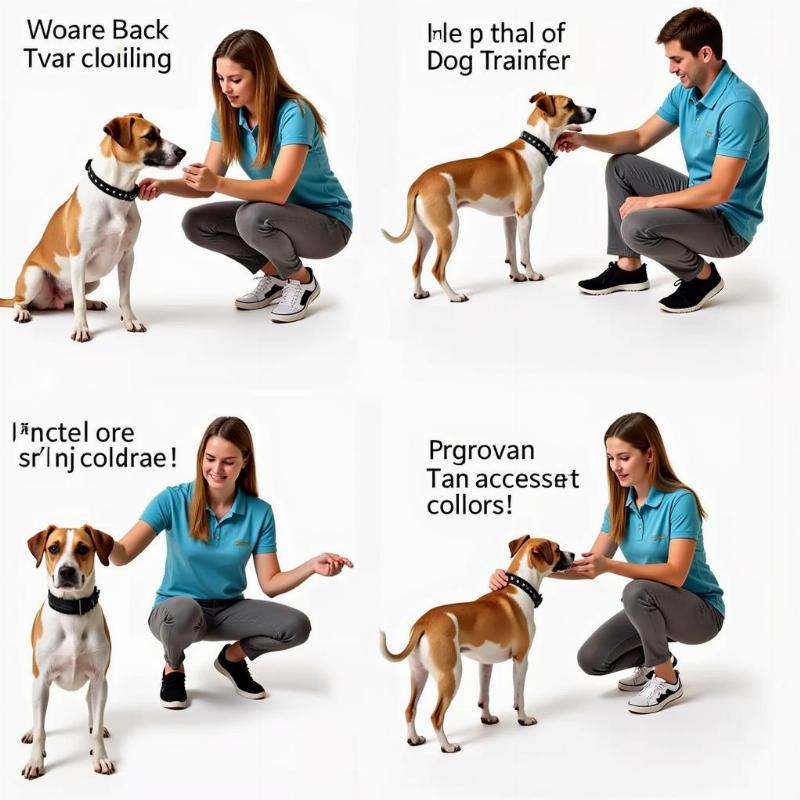Choosing the right training collar for your small dog can feel overwhelming. With so many options available, how do you know which one is best suited for your tiny companion’s needs and temperament? This guide will explore the various types of dog training collars available in the US, specifically designed for small breeds, helping you make an informed decision that prioritizes your dog’s safety, comfort, and effective training. We’ll cover everything from traditional collars to more modern options, ensuring you find the perfect fit for your furry friend.
Types of Dog Training Collars for Small Breeds
When it comes to small dogs, finding a training collar that’s both effective and safe is paramount. Because of their delicate tracheas and smaller size, certain collars are simply not suitable. Let’s delve into the most appropriate options for small breeds:
Flat Collars
Flat collars are the most common type and are generally used for everyday wear, ID tags, and leash attachment. While they can be used for basic training, they’re not ideal for dogs who pull excessively, as they can put pressure on the trachea. For small breeds, choose a lightweight, properly fitted flat collar.
Martingale Collars
Martingale collars, also known as limited-slip collars, are a safer alternative for small dogs who tend to slip out of their collars. They tighten slightly when the dog pulls, preventing escape, but unlike choke chains, they have a limited range of tightening to prevent choking. This makes them a humane and effective training tool for small dogs.
Harnesses
Harnesses are a popular choice for small dogs, especially those prone to tracheal collapse. They distribute pressure evenly across the chest and shoulders, reducing strain on the neck. There are various types of harnesses, including front-clip, back-clip, and no-pull harnesses, each offering different benefits for training.
Head Halters
Head halters work by gently controlling the dog’s head, which in turn controls their body. While effective, they can take some getting used to for both the dog and the owner. Ensure proper fitting and introduce the head halter gradually to avoid causing discomfort.
Choosing the Right Collar for Your Small Dog
Several factors influence the best collar choice for your small dog:
- Breed: Certain breeds are more prone to pulling or have specific sensitivities.
- Temperament: A timid dog might benefit from a gentler approach than a more boisterous one.
- Training Goals: Are you focusing on basic obedience, leash manners, or addressing specific behavioral issues?
- Comfort and Safety: Prioritize a collar that fits comfortably and doesn’t pose a choking hazard.
Tips for Effective Training with Collars
Regardless of the type of collar you choose, consistency and positive reinforcement are key to successful training. Here are some tips:
- Start Slowly: Introduce the collar gradually and associate it with positive experiences.
- Use Positive Reinforcement: Reward desired behaviors with treats, praise, or toys.
- Be Patient: Training takes time and consistency. Don’t get discouraged if your dog doesn’t learn immediately.
- Seek Professional Guidance: If you’re struggling, consider consulting a certified dog trainer.
 Training Small Dogs with Collars
Training Small Dogs with Collars
Conclusion
Finding the right dog training collar for your small dog is crucial for effective and humane training. By understanding the various options available and considering your dog’s individual needs, you can make an informed decision that sets both of you up for success. Remember to prioritize comfort, safety, and positive reinforcement throughout the training process.
FAQ
-
What’s the best collar for a small dog that pulls? A harness or a martingale collar is generally recommended for small dogs that pull.
-
Can I use a choke chain on a small dog? Choke chains are not recommended for small dogs due to the risk of tracheal injury.
-
How do I know if a collar fits my small dog correctly? You should be able to fit two fingers comfortably between the collar and your dog’s neck.
-
Are head halters safe for small dogs? Yes, when used correctly and fitted properly, head halters are a safe and effective training tool.
-
How long does it take to train a small dog with a collar? Training time varies depending on the dog, but consistency and patience are key.
-
What are some common mistakes to avoid when using a training collar? Avoid using punishment or negative reinforcement, and ensure the collar fits correctly.
-
When should I consult a professional dog trainer? If you’re having difficulty training your dog or if your dog exhibits signs of fear or aggression, consult a certified dog trainer.
Beautdogs.us is your premier resource for all things dog-related in the US. We offer expert advice on dog breeds, care, and product recommendations, catering to both new and experienced dog owners. Our mission is to empower you with the knowledge and resources you need to provide the best possible care for your beloved canine companion. For personalized advice or to explore our wide range of products and services, contact us today! Email: [email protected], Phone: +1 501-555-7529 or visit us at Beautdogs.us.